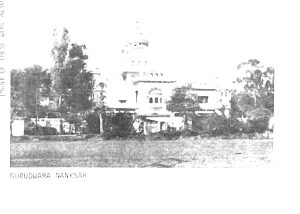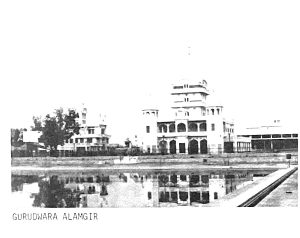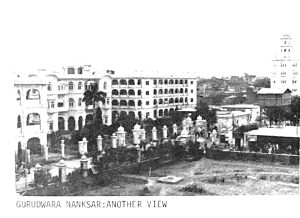Mahal at Agra, and the Golden Temple, in the Pool of Immortality at Amritsar The latter is the central shrine of Sikhism, and has been called by some authorities one of the most magnificent sights in all of India Here one finds a great pool of water over which passes a marble causeway to splendid temple with a gilded dome and many cupolas, one of those rare sights seen at intervals during life which fix themselves indelibly on the memory. 109
The collections of Guru Nanak’s preachings and the succeeding Gurus were compiled by the fifth Guru Arjun into the volume, Guru Granth Sahib, to give Sikhs a holy scripture which they could understand and follow Besides the writings of the Sikh Gurus it contains the compositions of Hindu, Muslim and untouchable saints and sages, such as Sadhna110 this was In keeping with the teachings of Guru Nanak who looked upon all Godly men worthy of reverence and visited the holy places of the Hindus in India and Muslims in Arabia and Iraq. Furthermore, all the Gurus who composed the hymns included in the Guru Granth Sahib, did so under the Nom-de-plume of ‘Nanak’, merging their own identity to that of the founder Guru. The identity of writers other than the Gurus has been kept though.111
By Guru Arjun’s time (1581-1606), Sikhism had evolved a distinctive language, scripture, ritual, communal life, and center In 1606 Guru Arjun gave blessings to Prince Khusrau’s unsuccessful rebellion against his father, emperor Jehangir, for which he was tortured and executed (May 30,1606) This is the beginning of the persecution of Sikhs under the Mughals. Guru Hargobind, the sixth Guru (1606-1644) grew up to be an all-round man, a saint and a warrior On the occasion of his accession, he wore two swords as emblems of spiritual and temporal manifestations – yr and Miri He encouraged Sikhs to bring him offerings of arms and horses in future and enrolled an armed body-guard of fifty-two mounted Sikhs These formed the nucleus of his future volunteer corps, and it was virtually the first step in the transformation of the Sikhs into a martial people Ever since the time, armed Sikhs have stood guard to Harmander Sahib (The Golden Temple) and the Aka/ 7akht as a symbol of temporal power of the Guru112 since the holy Granth was later proclaimed the Guru in perpetuity after Guru Gobind Singh, the tenth and the last living Guru, the tradition of posting the armed guards continues to this day The British and the Government of post-independent India honored this tradition and licensed the necessary for the guard The period of the seventh Guru Har Rai and the eighth Guru Har Krishan was relatively peaceful and uneventful during which spiritual awakening continued
Consequent to Emperor Aurangzeb’s increasing intolerance towards non-Muslims especially on account of Hindu “idolatrous forms of worship,” a deputation of Kashmir Brahmans sought the intervention of the ninth Guru Teg Bahadur to end the oppressive imperial policy of forcible conversion to Islam The Guru took up their cause and was arrested. Upon his refusal to accept conversion to Islam, he was beheaded in Delhi (November 11,1775) in public. 113
Guru Gobind Singh, the tenth and the last Guru, (1675-1708), completed the final transformation of the Sikhs into a martial community He said his father, Guru Tegh Bahadur had died “to protect the frontal marks and the sacred threads of the Hindus” and that he would uproot tyranny from the land 114 In 1699, he inaugurated the Khalsa, the sworn brotherhood of the Sikhs. At baptism into the Khalsa, the newly initiated were required to drink the sweetened water, stirred with a double edged sword, from the same vessel, without distinction to caste, creed or social status Sikhs were given five signs marking them off Hindu or Muslim – notably the uncut hair and the beard – and received the name of Singh, which means lion 115 According to Cunningham, Guru Gobind Singh caused the development of the Sikhs from “a sect into a people “116
Guru Gobind Singh lost all his four sons In his struggle for justice, the elder two, in their early teens, fell fighting against the Mughal forces (December 22, 1704) and the other two, not yet teenagers, were bricked alive and beheaded at the orders of Sirhind Governor Wazir Khan for refusing to embrace Islam (December 24, 1704). Guru Gobind Singh never returned to Punjab due to the hostility of the Hill rajas on the one hand, and the Muslim rulers of Punjab on the other and died in South India in October 1708, while convalescing from wounds inflicted by two Mughal assassins 117
Guru Gobind Singh was prolific poet and author His writings reflect the anguish of his times and the manner in which he responded to the circumstances He clearly visualized a politico-religious role for the Khalsa He considered justice to be birth right of man and wrote. “When all avenues have been explored, and all means tried, (to secure justice) it is lawful to have recourse to arms”118 one of the final acts of the last Guru was to ordain that decisions in secular affairs will be made by a Sikh congregation sitting in the presence of the Holy Granth Their verdict, called Gurmata would be binding on all Sikhs and an infringement of the same would be considered a sacrilege The decision would be executed by the Pan/ Pyare or the Five Chosen by consensus of the Sikh assembly. From here emerged the tradition of issuance of Hukam Namaby five priests 119 This notion rests on the institution of Panchayat, or the council of five, which speaks as one and “is said to be the voice of God, it gives expression to the consensus of the traditional moral order”120
Guru Gobind Singh’s contribution to Sikhism of distinctive value system and symbols is summed up by Cunningham “Success is not always the measure of greatness The last apostle of the Sikhs did not live to see his own ends accomplished but he actually roused the dormant energies of a vanquished people and he filled them with a lofty although fitful longing for social freedom and national ascendancy, the proper adjuncts of that purity of worship which had been preached by Guru Nanak A living spirit possessed the whole Sikh people, and the Impress of Guru Gobind Singh has not only elevated and altered the constitution of their minds, but has operated materially and given amplitude to their physical frames.” 121
Under the command of Guru Gobind Singh’s disciple Banda Singh Bahadar (1708-16), the Sikhs held sway over the eastern Punjab for a brief period The Mughal empire was yet too strong for the rising power of the Sikhs which was put to heel quickly. For the next fifty years or so, they resorted to relentless guerilla warfare to fight back the Lahore Durbar. Orders were issued to root out Sikhs.122 The governor, Yahiya Khan,” issued a proclamation for a general massacre of all Sikhs, wherever they could be found” A price indeed was put upon their head,123 and so vigorously were the measures of prudence, or of vengeance followed up, that many conformed to Hinduism, others abandoned the outward signs of their belief, and the more sincere had to seek a refuge among the recesses of the hills, or in the woods in the south of the Sutlej124 They were relentlessly hunted down by the ten thousand strong force of Central Asian Turani mercenaries in the employ of Abdus Samad Khan, who made such a clean sweep of them that “the very name of Sikh became extinct in the province of the Panjab”125 and in the words of Cunningham “The Sikhs were scarcely heard of in history for the period of a generation 126
During the period 1708-1765 Sikhs suffered two Ghallugharas, or holocausts, one in June 1746 and the other in May 1762 127 Anmad Shah Abdali sacked and occupied the city of Amritsar in early 1757 with great loss of Sikh lives. Baba Deep Singh, first head of the Damadamy Taksal, the Sikh seminary of which Sant Bhindranwale was the fourteenth chief, led poorly armed peasants to free the Golden Temple of the Afghans and in the process kept “his tryst with death” The death of Baba Deep Singh and others galvanized the Sikhs who during the next thirty years waged a successful irregular war against the Mughals and succeeded in establishing numerous autonomous areas under different misalsby the end of 1760s128 These areas were consolidated by Maharaja Ranjit Singh in a united Sikh state by 1799 which lasted till the British defeated the Sikhs and assumed full control of Punjab by mid nineteenth century
The capsule account gives some idea of Sikh aggregative personality: that of ever-readiness to fight perceived injustice, intense pride in Sikh symbols of valor and sacrifice, doggedness and perseverance in adversity.
Table 1
Sikh Mobilization for Indian Freedom Struggle
Until 1947
Total Sikh Percent
Prison term over 1 year 2125 1550 75%
Deported 2646 2147 80%
Death sentence 127 92 80%
Sources. Kamath, MV in Shourie’s 7he Punjab Tragedy, p 150; Also Swamy, S. in 7he //lustrated Week ly, May 13, 1984, p 11.
and participatory mobilization to defend its cause whatever the price. Relating the above derivation to contemporary events, Sikhs with about 1 percent population of undivided India (until 1947), mobilized to notable proportion for the Indian freedom Struggle as shown in Table 1.
Cunningham’ classic account of the warfare and intrigue through which Sikh power was established in the Punjab is permeated with the recurring theme of the development of the Sikhs from “a sect into a people” under Guru Gobind Singh and from a people to a “nation under Ranjit Singh”129 Cunningham was more impressed by the differences than by the similarities between Sikhs and Hindus, when he remarked that “it has been usual to regard the Sikhs as essentially Hindu, and they doubtlessly are so in language and everyday customs… yet in religious faith and worldly aspirations, they are wholly different from other Indians and they are bound together by a community of inward sentiment and of outward object unknown elsewhere,” 130
Sikh consciousness consolidated progressively as a result of series of events during the last century. To state a few: Sikh opposition to cow- Slaughter resulting in blowing-up individually of sixty five Sikhs by the British Deputy Commissioners of Ludhiana and Ambala;131 Sikh renaissance in the form of Singh Sabha movement and Chief Khalsa Diwan in the last quarter of the 19th century,132 successful agitation over Colony Bill 1907 which resulted in withholding sanction to the Bill by Lord Minto,133 massive Sikh participation in the passage of Gurudwara Act of 1925, 134 institutional manifestation of Sikh aspirations in the form of Sri Gurudwara Prabadhak Committee and Akali Dal, which according to Brass provided critical arena for Sikh mobilization,135 successful Akali Morcha during the 1950s and 1960s for creation of Punjabi linguistic state; growing revivalism among the Sikhs since 1970s; continuing large scale protest for greater political and economic autonomy in the early 1980s and after the 1984 events, demand for a homeland among growing number of Sikhs.








